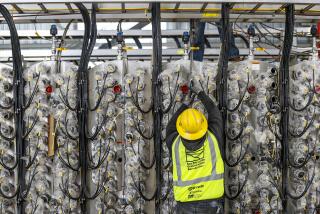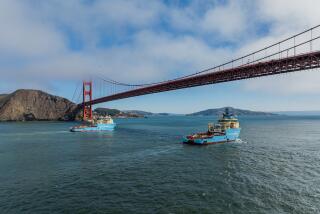When Superfund expenses go ‘mega’
FORT EDWARD, N.Y. — After the winter thaw, a huge enterprise -- so expensive and risky that it ranks among the most ambitious environmental projects on Earth -- will rise up from an abandoned cornfield in upstate New York.
Not far from Saratoga, where Americans defeated British soldiers in the Revolutionary War, 40 miles of the Hudson River will be excavated to remove hazardous compounds discharged by General Electric. The project, expected to cost more than $700 million, will rival the price of the new Yankee Stadium and remove enough toxic mud to fill the stadium twice.
Yet, despite 50,000 tests of the river sludge and three decades of review, there are no guarantees that this cleanup will succeed.
The Hudson River is one of 154 places across the country -- 16 in California -- dubbed Superfund “mega sites” because eliminating their toxic chemicals is such a big and costly job. And like this project, in which dredging could stir up even more chemicals, many of them involve huge investments in uncertain outcomes.
Mega cleanups -- those expected to cost more than $50 million -- usually last for decades. For some, there’s no end in sight.
In Southern California, off the Palos Verdes Peninsula, the U.S. Environmental Protection Agency is trying to decide the best way to immobilize a huge ocean-floor deposit of the pesticide DDT that has been poisoning fish and other marine life for decades.
Near Redding, on a mountain fractured by a huge copper and silver mine that opened in 1879, the EPA has constructed a dam and diverted a creek to try to contain a continuous flow of acids and metals that will probably go on forever.
In Butte, Mont., one mega site is so notorious that it has become a tourist attraction. At a viewing stand above an old copper mine, visitors peer into a 900-foot-deep pit of toxic waste. When migratory birds land on this brew of acids and metals, mistaking it for a watering hole, they die.
‘Blight on communities’
Yet EPA officials say tackling such engineering challenges is justified because doing nothing at these super-sized toxic sites poses an even worse threat to human health, the environment and the economy.
“Usually, they are a blight on communities. In our case, the stigma of the contamination is hurting the economy of the upper Hudson,” said David King, the EPA’s Hudson River project manager.
Twenty-six years after Congress passed the Superfund law to clean up the nation’s most dangerous dumping grounds, the list of mega sites keeps growing as more mines, landfills, military bases and factories qualify.
Superfund’s national priority list includes more than 1,200 chemical sites, but only one of every eight rises to “mega” status. New Jersey leads with 18, but California’s 16 megas will soon more than double, with 18 others expected to meet the $50-million mark.
“State programs can deal with garden-variety sites, but mega sites are ones that nobody but the federal government can deal with,” said Katherine Probst, a senior fellow at Resources for the Future, an environmental think tank in Washington, who has researched Superfund for 15 years.
Mega cleanups averaged $140 million each in 2000, 10 times the standard Superfund project, according to Resources for the Future. California’s 16 mega sites’ cost estimates range from $100 million to $450 million, said Elizabeth Adams, the EPA’s regional Superfund cleanup chief in San Francisco.
“Today, a real mega site is well over the $100-million mark. Sadly, $50 million may not be what it once was,” Probst said.
Funding lags behind
Yet federal funding for Superfund oversight has not kept up with the surge in mega sites, and many cleanups remain in the early stages. At 22% of all sites, human exposure to chemicals is not under control, the EPA says.
Polluters pay for most cleanups, but Superfund’s annual budget, which supports EPA analyses, has remained at about $1.2 billion since 1987. With inflation, that is a 40% decline.
“The Superfund program’s real purchasing power has decreased dramatically at the same time that large, complex and expensive sites -- often referred to as mega sites -- make up an increasing proportion of the program’s workload,” Probst said at a congressional hearing in June.
What makes a site such a headache that it becomes a mega? “It’s the number of contaminants, the size, how far the contamination has spread and how remote it is,” Adams said.
Some, such as the Hudson River, involve one company and gigantic volumes of a single pollutant. Others, such as a Monterey Park landfill that towers over surrounding hills, have multiple chemicals and sources.
In the Northeast, many megas are old factories. But around Los Angeles, the worst are immense underground basins in which water supplies, polluted by industrial solvents, have had decades of pumping and treatment. The San Gabriel Valley aquifer is the state’s most expensive mega cleanup, expected to reach at least $450 million.
“A lot of these industries came in during the ‘40s, and these underground plumes are now miles long -- sometimes six or seven miles,” Adams said. “It’s a huge effort, and very costly, to make sure everything meets drinking-water standards.”
The trickiest megas -- 11 including the Hudson River -- are underwater. Dredging them risks uncovering more polluted layers or leaving toxic residue.
“It’s not like vacuuming your carpet,” said Richard Luthy, Stanford University’s chairman of civil and environmental engineering and a member of a National Research Council committee on mega sites. “You are, in every case, left with some material on the bottom that you haven’t completely picked up. Just because you can dredge doesn’t mean you can get everything.”
At a small cleanup in San Francisco Bay’s Richmond Harbor, DDT-laden sludge was dredged in 1997. But high concentrations resurfaced a year later. A sloped bottom and barge debris complicated the work.
With problems at small sites, Luthy said, “you have to wonder about the big sites. You might actually make them worse.”
The most unusual underwater site is half a mile deep in the Pacific, a mile off the Palos Verdes Peninsula. For 25 years, a pesticide plant near Torrance released DDT into sewers. Now the EPA is trying to decide whether to use clean sand to cap part of the deposit, which covers several square miles of ocean floor.
Decades of analysis often occur before the EPA decides whether to dredge, cap, dam, pump -- or some combination. At many, the EPA wrestles with remedies that might be ineffective -- or worse.
Hazards of cleanup
In the Hudson River Valley, the debate over dredging has gone on for three decades, predating Superfund.
Two GE plants discharged as much as 1.3 million pounds of polychlorinated biphenyls, or PCBs, into the river for 30 years beginning in 1947. Used to insulate large electrical equipment, the PCBs, which are likely human carcinogens and can disrupt immune systems and brain development, rendered the river’s fish inedible.
GE maintained that removing PCBs from the Hudson was too risky, and in 1984, the EPA agreed. The agency reversed course in 2001, concluding that dredging could be done safely and setting performance standards. Finally, in a November court settlement, GE agreed to dredge 10%. If an independent panel approves the results, GE can voluntarily dredge the rest or face a likely EPA order.
The main risk, King said, is unleashing buried PCBs. To reduce that threat, clamshell buckets will tightly seal as they bring mud to the surface. Work will stop if water standards are violated.
“Technically, it’s not anything exotic; it’s the size and the logistics that make it a challenge,” he said. “I can’t recall anything of this scale before.”
The dig will remove 2 million cubic yards of PCB-contaminated mud. Another PCB cleanup along Wisconsin’s Fox River could dredge a record 7 million cubic yards. “That makes them the largest by volume and us the largest by cost. Both are dubious honors,” King said.
This spring, before the first bucketful is scooped in 2008, workers will descend on Fort Edward, a town of 6,000, to build a treatment plant, rail tracks, a wharf, marina, rail yard, utility lines and filtering presses. That alone is “like constructing a small city,” said John Haggard, GE program manager.
Dug up by mechanical dredgers, the mud will be transported by barges and tugs to the plant, where the PCBs will be extracted, squeezed through presses, then hauled by 81-car freight trains to a landfill.
The dredging is expected to last six to eight years, but after decades of delay in the start-up, Hudson River Valley residents are skeptical about when the toxic mud will be gone.
In Fort Edward’s museum, a sign reads: “The roots of the present lie deep in the past.” For residents of mega-site communities, the past, present and future are defined by a toxic legacy.
“We could come back two decades from now, and it will still be going on,” said Peter Berle, New York’s former environmental commissioner. “Hopefully, someday, we’ll be free of PCBs.”
*
(BEGIN TEXT OF INFOBOX)
Mega messes: the worst of the worst
California has 93 sites that qualify under the Superfund law as the nation’s most dangerous dumping grounds for chemical waste. But 16 of them are so big and complicated that they are called “mega sites,” where cleanup costs are expected to exceed $50 million. Estimates range from $100 million to $450 million each.
1. Iron Mountain Mine, Shasta: Acidic waste draining into streams
2. Aerojet, Rancho Cordova: Groundwater contaminated by aerospace waste
3. McClellan Air Force Base, Sacramento: Solvents contaminating groundwater
4. Lawrence Livermore National Laboratory, Livermore: Naval base wastes contaminated groundwater
5. Ft. Ord, Monterey: Solvents contaminated groundwater
6. Casmalia Resources, Santa Maria: Waste landfill with millions of pounds of chemicals
7. Edwards Air Force Base, Lancaster: Groundwater contaminated by aircraft fuel/solvents
8. San Fernando Valley, North Hollywood/Glendale: Groundwater polluted by industrial solvents, metals
9. Operating Industries, Monterey Park: Landfill containing hundreds of chemicals
10, 11, 12. San Gabriel Valley (3 sites): Groundwater polluted by industrial solvents
13. Newmark, San Bernardino: Groundwater polluted by industrial solvents
14. Stringfellow, Riverside County: Landfill with chemicals polluting groundwater
15. Montrose Chemical Corp., Ocean off Palos Verdes Peninsula: World’s largest DDT deposit from pesticide factory near Torrance
16. McColl, Fullerton: Landfill for oil refinery waste
---
A searchable database of Superfund sites is at:
cfpub.epa.gov/supercpad/cursites/srchsites.cfm
---
Source: Environmental Protection Agency, ESRI, USGS
More to Read
Sign up for Essential California
The most important California stories and recommendations in your inbox every morning.
You may occasionally receive promotional content from the Los Angeles Times.










